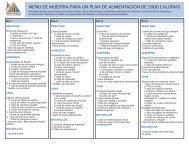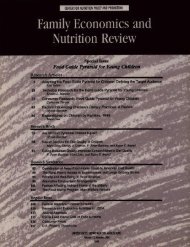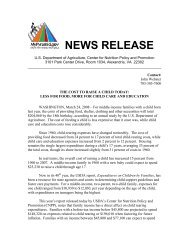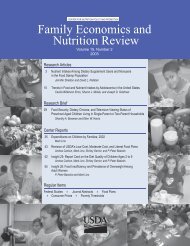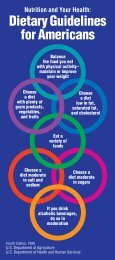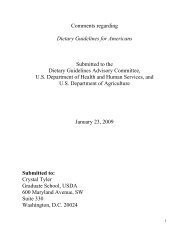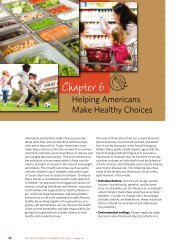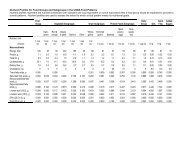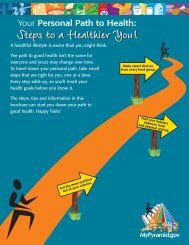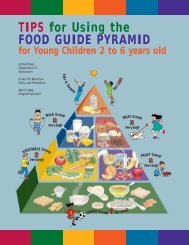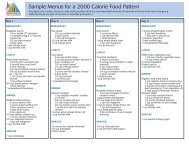Elderly Nutrition - Center for Nutrition Policy and Promotion - US ...
Elderly Nutrition - Center for Nutrition Policy and Promotion - US ...
Elderly Nutrition - Center for Nutrition Policy and Promotion - US ...
Create successful ePaper yourself
Turn your PDF publications into a flip-book with our unique Google optimized e-Paper software.
Researchers completed <strong>and</strong> compiled<br />
the qualitative data in the <strong>for</strong>m of tape<br />
recordings <strong>and</strong> h<strong>and</strong>written notes.<br />
During analysis, the researchers<br />
reviewed both the notes <strong>and</strong> the tapes<br />
from each focus group session <strong>and</strong><br />
then used the tape recordings to<br />
complete the notes. Next, researchers<br />
identified barriers, placed the individual<br />
barriers into categories, <strong>and</strong> organized<br />
the categories into patterns or themes<br />
<strong>and</strong> concepts (e.g., related to a predisposing<br />
or an enabling factor).<br />
Results <strong>and</strong> Discussion<br />
The focus group attendance was<br />
excellent, with only six no-shows.<br />
Six other participants attended a focus<br />
group session other than the one they<br />
had originally planned to attend. By<br />
casual observation, we noted that all<br />
but two of the participants appeared to<br />
be able-bodied: one revealed a hearing<br />
loss <strong>and</strong> one used a walker. Even<br />
though over half (n=28) of the African-<br />
American seniors in this study reported<br />
income below the poverty index<br />
(Annual Update of the HHS Poverty<br />
Guidelines, 1999), finances were rarely<br />
mentioned as a barrier to adequate<br />
calcium intake in the focus groups.<br />
These seniors seemed adept at managing<br />
their finances, <strong>and</strong> 40 percent used<br />
resources other than congregate meals,<br />
frequently citing commodity foods as<br />
supplements to their food budgets.<br />
Most African-American participants (84<br />
percent) agreed to provide demographic<br />
in<strong>for</strong>mation (table 1). Six of ten participants<br />
had less than a high school<br />
education, about 6 of 10 had a monthly<br />
income of less than $700, <strong>and</strong> about 6 of<br />
10 were not receiving food assistance.<br />
Almost three-quarters of the participants<br />
were single, separated, divorced,<br />
or widowed; over half (57 percent) lived<br />
alone. Most of the 56 participants<br />
(n=47) completed the food preference<br />
survey, which indicated that greater<br />
than 90 percent of the respondents<br />
liked <strong>and</strong> ate milk <strong>and</strong> dairy products<br />
as well as some other foods with<br />
moderate or high amounts of calcium<br />
(e.g., salmon with bones). However,<br />
some participants, while reviewing a<br />
list of calcium-containing foods, noted<br />
unfamiliarity with relatively new products<br />
such as tofu. In terms of general<br />
categories of calcium-containing<br />
supplements (calcium, antacids, or<br />
vitamins <strong>and</strong> minerals), 83 percent of<br />
the participants reported using supplements<br />
of various types daily, weekly,<br />
or seldom. Fifty-five percent reported<br />
taking at least one of the calciumcontaining<br />
supplements daily, 13<br />
percent reported using calcium supplements<br />
or other antacids (e.g., Tums),<br />
<strong>and</strong> 49 percent reported using vitaminmineral<br />
supplements (data not shown).<br />
Focus group discussions revealed a list<br />
of barriers to calcium intake among<br />
African-American seniors:<br />
• concern <strong>for</strong> health <strong>and</strong> disease<br />
states<br />
• lack of nutrition knowledge<br />
• behaviors related to dairy products<br />
• limited food preferences<br />
• concerns about finances<br />
• lack of food variety<br />
• concerns about food sanitation<br />
• limited food availability<br />
Two subcategories represented the<br />
barriers: predisposing factors <strong>and</strong><br />
enabling factors. Researchers identified<br />
four types of barriers related to predisposing<br />
factors: customs <strong>and</strong> beliefs,<br />
food h<strong>and</strong>ling/sanitation, nutrition<br />
knowledge, <strong>and</strong> health reasons/disease<br />
state/food intolerance. Researchers also<br />
identified four types of barriers related<br />
to enabling factors: food preferences,<br />
financial issues, food variety <strong>and</strong><br />
availability, <strong>and</strong> behaviors. In terms<br />
of food preferences, the participants<br />
discussed the need to learn to eat <strong>and</strong><br />
learn to like new foods to increase<br />
calcium intake. Participants identified<br />
Table 1. Demographic characteristics<br />
of African-American seniors<br />
Variables<br />
Percent<br />
Educational level 1<br />



